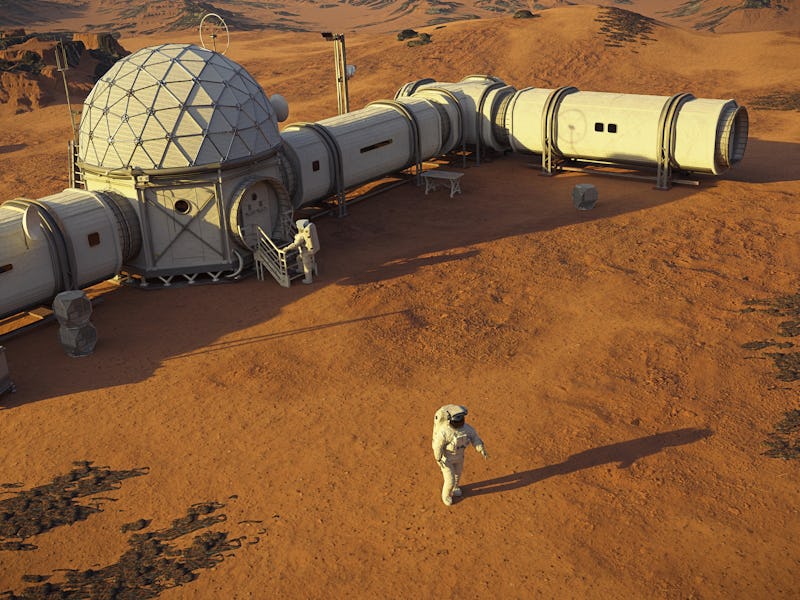SpaceX’s Mars city has come a step closer after a series of NASA missions
The SpaceX CEO is looking to build a Mars city, and its NASA contract could fuel its creation.

A city on Mars? SpaceX has been training this whole time, Elon Musk declared Sunday.
The SpaceX CEO took to Twitter to decry his company's slow rate of progress in sending humans to Mars to set up a city. The firm is currently working on the Starship, a fully-reusable rocket designed to transport humans to Mars and beyond, which Musk noted is step one of three toward reaching this goal.
Musk also explained how the company has been working on step two of three through its existing resupply missions. The second step is orbital refilling, which will enable the Starship to refuel in space and continue its mission to the red planet.
On Sunday, YouTuber Tim Dodd asked Musk about current progress on the firm's research in this area in collaboration with NASA. Musk responded:
SpaceX has a lot of experience berthing & now docking with [the International Space Station], which is very difficult. Orbital refilling should in theory be easier, since Starships dock with themselves & will be uncrewed at first.
Orbital refueling is key to reaching Mars with an efficient rocket design. The problem is similar to planning a cross-country road trip: you could design a car that can hold enough fuel for the whole trip, but it's more efficient to design a car with a smaller tank that can refuel at logical stops. Musk explained in September 2016 that without orbital refueling, a Mars spaceship would need to be five to 10 times bigger.
SpaceX's Dragon capsule.
That means the Dragon capsules, which have powered SpaceX and NASA's resupply missions, have been quietly helping SpaceX build up the expertise to one day send humans to Mars. These "Commercial Resupply Services" missions, which spanned 20 launches over eight years from October 2012, enabled NASA to send science experiments and other goods to the International Space Station.
The missions have helped propel SpaceX's work into the spotlight, sending up thousands of pounds of equipment for third parties to test their ideas in microgravity. For the 20th mission last month, for example, a pair of Adidas Boost shoes were included in the over 4,300 pounds of cargo sent to the space station. The missions are also a chance to send supplies back to Earth: the CRS-20 capsule returned earlier this month with around 4,300 pounds of cargo.
Beyond Dragon, SpaceX has been working with NASA to research how best to refuel rockets in space. NASA announced in August 2019 plans for both the Glenn Research Center in Cleveland and the Marshall Space Flight Center in Alabama to work with SpaceX on the issue. Musk wrote at the time that orbital refueling is "vital to humanity’s future in space," adding that spacecraft-to-spacecraft was likely to form the first setup rather than any sort of futuristic space depot.
SpaceX is set to expand on the Dragon missions further in two key ways. The first is the Crew Dragon, a manned capsule that will ferry humans to the space station. The capsule's first manned test mission, "Demo-2," is targeting a May 27 launch date. The second is with the Dragon XL. This is a special version of the cargo capsule that will support the Lunar Gateway, NASA's planned spaceship designed to support manned lunar missions as part of the Artemis project.
The firm has big plans for Starship. It's currently building prototype versions of the rocket at the Boca Chica facility in Texas, with the goal of completing an orbital launch. A launch of 150 meters into the air, with a miniaturized version of the ship called "Starhopper," was completed in August 2019.
The Inverse analysis
Orbital refueling remains one of the big issues the firm will need to tackle, and the Dragon capsule is not the only way its partnership with NASA will be helpful.
The agency's expertise in this issue could prove invaluable. NASA sent up the Robotic Refueling Mission 3 in December 2018, with the goal of storing 42 liters of fluid in cryogenic temperatures for up to six months. The goal was to improve the technology around holding fuel for an extended period. Unfortunately, the agency announced in April 2019 that it had failed and the liquid's temperature rose and became a gas. The agency claimed the experience helped them understand what technologies are needed to store fuel for longer.
SpaceX has a big challenge on its hands if it wants to use orbital refueling to build a Mars city by 2050.